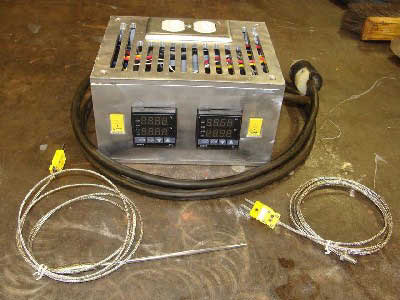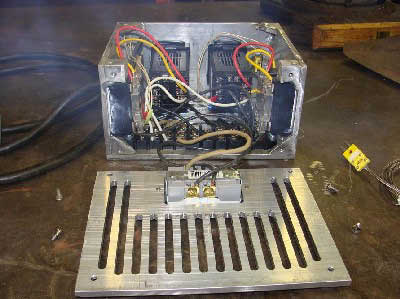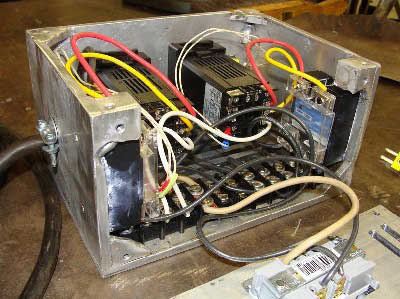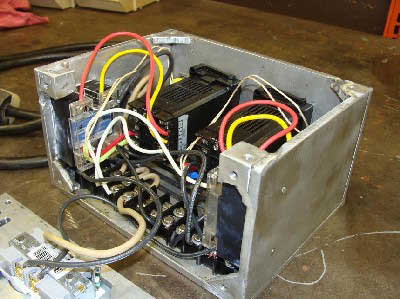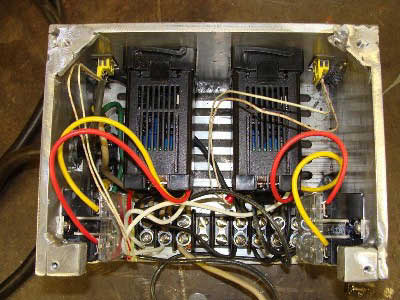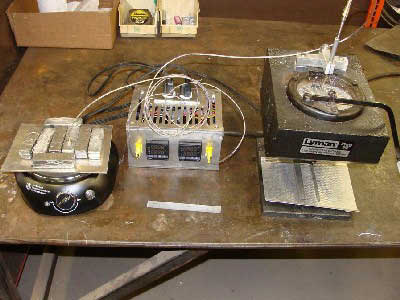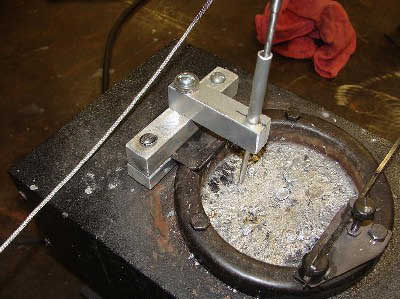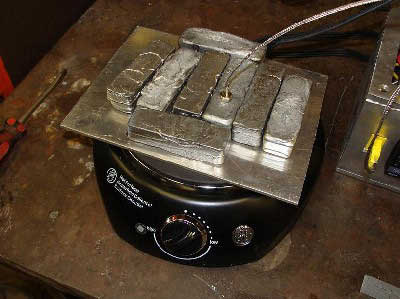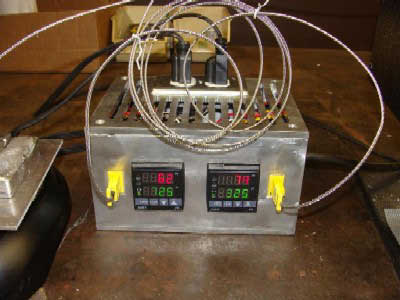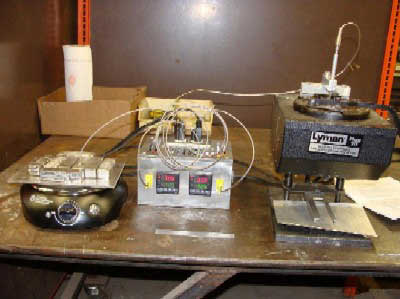|
As part of a long term process of developing the
technology and knowledge base to make custom bullet molds it was necessary to
have available a means to control and monitor the temperature of a lead
melting pot and a bullet mold. I decided to build a dual temperature
controller using digital PID controllers, appropriate type K thermocouples,
and other components supplied by Auber Instruments Inc.
A PID controller is a device that compares the set point value (what you want)
to the actual process value (what you've got) from your sensor over a period
of time. PID stands for Proportional-Integral-Derivative. Proportional control
merely looks at the difference between set point and process values to
determine whether to turn on or off an output. A simple bimetallic thermostat
operates this way, but this mode of control produces
overshooting/undershooting and a constant cycling of the process value above
and below the set point value Derivative refers to the rate of change of the
process variable over time as control action takes place. Integral control is
based on the total time and magnitude of the error between the process value
and the set point value. These latter two modes are designed to minimize
undershoot/overshoot and improve system stabilization. These particular
controllers have a discrete (on/off) output; during operation the controller
cycles it on and off for certain time periods to maintain control as closely
as possible.
The Auber PID controllers have a number of user-friendly features that make
them work well for this type of application. They accept analog input directly
from a thermocouple (and other sensors), can be operated on a range of input
AC voltages, and can be had with internal relay outputs or DC outputs to
operate external mechanical or Solid State Relays. They also can actuate
external alarms (which I am not utilizing in this application), will auto-tune
themselves, and are small and relatively inexpensive.
Parts List
2 - PID controllers Auber #SYL-2352 $89.00
1 - Type K thermocouple w/6” probe Auber #WRNK-171 $13.50
1 - Type K thermocouple ¼ -20 probe Auber #TC-K6 $6.85
2 - 25A Solid State Relays Auber #RS1A40D25 $30.00
2 - Panel mount thermocouple connectors Auber #TCCON $9.80
1 - dual outlet 110VAC female socket $3.00
1 - cable clamp $1.00
1 - approx 48” of 1/4” x 6” 6061 aluminum plate $24.00
1 - fuse holder and box of 20A Type T fuses $5.00
1 - tube of heat sink silicone grease $4.00
1 - 110VAC three prong male plug -
1 - terminal strip -
1 - 6' 12 ga 3 conductor stranded rubber coated cable -
miscellaneous 14 ga hookup wire (red, yellow, black, white) -
miscellaneous crimp on connectors -
miscellaneous screws -
bits and pieces of repurposed shop scrap -
(un-priced items are items I had on hand) Total* $186.15
*(Total does not include the $19.50 for three orders from Auber; I should have
made one order and saved $13.00)
Construction:
I wanted to make a fairly compact unit so a 3-D CAD system was used to aid the
design process. The Auber site has technical information on their products,
including the dimensions of the major components. Other components that were
on hand were simply measured using suitable tools. Each component was turned
into a simple rectangular object and locate in space to enable the box to be
built around it. The overall dimensions of the box ended up being 8" long,
4-1/2" high, and 6-1/4" deep. Once this was done it was easy to take the six
box panels and locate hole centers and other relevant features. Each panel was
then dimensioned and printed as an individual part to take to the machine
shop..
The box panels are made from 1/4” aluminum plate which was cut to size by
sawing and milling. All the holes were drilled and counterbored where required
using a vertical milling machine. The square holes in the front panel for the
two PID controllers were milled, as were the holes for the thermocouple
socket. The thermocouple sockets were designed to be mounted on 12 – 16 gauge
sheet metal so these had to be recessed into the front to allow the rear
spring clip to lock them in place. The area around the cable clamp hole on the
inside of the right panel was also relieved for the same reason. The hole for
the 110VAC socket was also milled out.
The holes were tapped using a hand tapping machine.
The bottom, front, and both sides were then clamped up to maintain size and
squareness and TIG welded on the inside. The corner brackets used as
attachment points for the top and back panels were then welded in place.
The box was then returned to the mill and the holes for the top and rear screw
holes were drilled, again followed by hand tapping. The box was then assembled
to give it rigidity and clamped into the mill vise, where the bottom vent
slots were cut. The top was removed and clamped in the vise and the vent slots
were cut.
All the components were given a thorough cleaning, first in a parts-washing
tank, followed by a wipe down with acetone.
The terminal strip for the 110VAC connections and the fuse holder were screwed
into place first, followed by the cable clamp. The 110VAC cable was then
anchored into place. The black (hot) lead had a female spade lug crimped on
and then it was connected to the fuse holder. The white (neutral) wire was
extended to the terminal strip where it was stripped at intervals and looped
around the screws on one side of the terminal strip. The green (ground) wire
was connected to one of the mounting screws on the end of the terminal strip,
where it would ground to the case. A jumper wire with a female spade lug
crimped on one end and stripped at intervals on the other end was used to
connect the fuse holder to the terminal strip.
The thermocouple wires were then cut off by about six inches to provide a
length of wire to go from the thermocouple socket to the controller. The cut
ends were stripped and bent into a loop. The thermocouple was connected to the
male plug, and the short section was connected to the female socket., leaving
the spade lugs unconnected for the moment. Polarity is very important here -
my thermocouple wires were marked red positive and had a red thread in the
wire covering.
The SSRs are mounted with the power terminals on the bottom, where the
terminal strip makes inserting the wire difficult, so 12 gauge black jumpers
wire connected before they were mounted to the case. Heat sink grease was
applied to the bottom of the SSRs before mounting.
The PID controllers each had four eight inch long 14 gauge jumper wires
connected – black and white to the AC power terminals, red to the positive SSR
coil output, yellow to the negative SSR coil output.
The thermocouple sockets were inserted and anchored into place with the
supplied spring clips. The PID controllers were inserted into the face and the
retaining clips were put on loosely. The thermocouple wires were connected to
the proper terminals on the PID controller, which was then securely anchored
with the spring clip. The yellow and red wires hooked to the proper polarity
terminals of the SSR, and the white and black wires connected to the 110VAC
terminal strip.
One of the power wires of the SSR was connected to a black (hot) terminal on
the terminal strip. The other was connected to one of the brass terminals on
the 110VAC socket. The 20A socket had the connector strip on the side removed
so that each plug-in was controlled separately. The silver (neutral) side of
the socket was not altered so only one white wire was needed to connect it to
the terminal strip. No ground wire was used as the socket grounds to the box.
The 110VAC socket was then mounted to the top panel and a metal cover was
secured in place. A fuse was inserted into the fuse holder and the top and
back panels were then mounted to the box. A three prong male plug was
connected to the end of the power cable, completing the assembly.
Operation:
The thermocouples were plugged in and the unit was plugged into a heavy duty
extension cord on a 20A branch circuit. It was thrilling when nothing exciting
happened and everything powered up normally. The units were preset at 50F and
the thermocouples were exposed to ambient air temperature and within a few
minutes both stabilized within one degree of the same 67-68F temperature
reading.
With everything working normally it was time to test the unit. A simple
thermocouple holder for the Lyman 20 pound bottom pour lead pot was made from
shop scrap. It allows the thermocouple probe to be inserted into the melt to a
consistent depth and can be swung out of the way for fluxing when the probe is
removed.
Since a bullet mold was not available for preheating, a one pound lead ingot
was drilled and tapped with a 1/4-20 thread and the other thermocouple was
screwed into it. A protective aluminum plate was placed over the hot plate
used for preheating and eight ingots, including the instrumented one, were
placed on top.
The Lyman furnace and hot plate were plugged into the appropriate sockets and
both units were turned all the way one, effectively cutting out the
thermostats built into each unit and allowing the PID controller to cycle the
power to the devices. Again nothing exciting happened.
The set point value of the controllers were then entered. The lead pot was set
to 725F, the hot plate to 325F. Within a minute or two the temperature reading
began to increase. Within 10 – 12 minutes the hot plate was approaching the
desired temperature and the auto-tune function was engaged. It overshot the
temperature by about 40F the first time but settled down within a few minutes
and held temperature within about +/- 10F after a while. This was not
unexpected, as it is a system with a powerful input to a low thermal mass with
a lot of surface area exposed to air currents.
Within about 20 minutes the lead pot was approaching the set point value and
the auto-tune was engaged. It overshot by about 30F at first but stayed within
+/-5F after that, with +/- 2F control most of the time. No material was added
or removed from the pot at this time so how good control will be during
operation is yet to be determined. It is expected that temperature swings can
be minimized by preheating ingots to a consistent temperature on the hot
plate.
In the future I plan to attach a thermocouple to several special molds, but I
do not plan to drill and tap all my molds. I think that putting a mold in the
middle of a bunch of ingots held at a specific temperature on a hot plate
would work just fine.
The system was operated at steady-state conditions for several hours. At no
time did the area of the side panels under the SSRs get warm enough to feel.
No heat was felt coming through the air vents on the top. Despite the small
size of the unit it runs cool. So far I am pleased with the results.
Pictures Included here are various shots of the completed unit:
|
